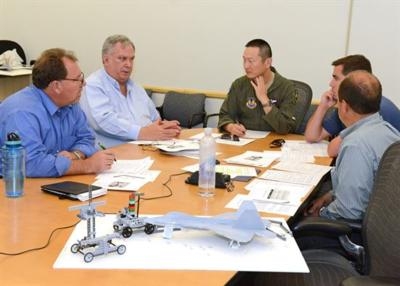One-Day Event Consisted Of Three Teams
The 412th Test Wing’s Experimentation Center for Ideas/Technology Exploration team, known as XCITE, hosted a one-day innovation challenge July 10, 2017.

Several engineers from around Edwards Air Force Base partnered with members of the Desert High School Robotics team to come up with a solution to a real-world test problem.
The one-day competition consisted of three teams that brainstormed ideas and designed proposals during the morning session and in the afternoon presented their solutions to a panel of leaders from various organizations on base.
“The goal of the day was for 412th TW participants to gain training and experience working on a rapid development innovation project team, briefing leadership and then selling their idea; while robotics team students gained experience working with professionals on a real-world problem with real constraints,” said T.J. Wuth, an XCITE member. “The students also had the opportunity to apply science, technology, engineering, and mathematics principles and to learn about federal acquisition.”
The three teams were put together to come up with a way to gather ground-based radio frequency imagery of an F-22 Raptor more effectively.
At the F-22 Combined Test Force, engineers routinely use a repair verification radar to collect ground-based images of an F-22 Raptor. The RVR system uses radar technology to measure the signature of an F-22, which is essential to the fifth-generation fighter’s stealth capabilities.
However, at 500 pounds, the RVR is cumbersome to maneuver, and for a full 360-degree analysis, the RVR is required to be moved to 25 locations around the jet. The RVR also has a tight tolerance with regard to where it is positioned at each location. These time-consuming procedures can be costly, as F-22s from around the Air Force come to Edwards AFB for low observability analysis.
The task for the three innovation teams was simple -- develop and present a solution to more effectively maneuver the RVR around the aircraft to collect RF imagery. The teams developed design concepts by analyzing information on the RVR and the F-22 Raptor. Visual models of mobile platforms to move the RVR were rapidly constructed out of Lego robotics kits and specifications of the different designs were documented on poster paper. The teams also came up with how much their perspective designs would cost to implement. The proposed costs ranged from $13,000 to almost $30,000, a fraction of the cost of the test equipment and man hours currently required to perform the measurements, according to Wuth.
In the end, the judging panel chose Team #2’s idea of having a mobile platform with omnidirectional wheels that can also enable the RVR to pan and tilt. The team’s design would also use lasers to calibrate the accuracy of the RVR’s locations.
Team #2 narrowly beat out Team #1 whose concept was to build a track – similar to a camera track that professional film makers use – so that the RVR can move around the F-22 as needed. The judges viewed Team #2’s proposal as a little more of a practical and realistic approach to fielding rapidly.
The engineers at the F-22 Combined Test Force will now examine Team #2’s concept further and see about implementing the project.
Brig. Gen. Carl Schaefer, the 412th TW commander, has challenged the Edwards AFB workforce to foster a culture of innovation to improve processes and products for the future. “The RVR challenge gives leadership the opportunity to see grassroots innovation efforts in action and empower participants to move forward,” Wuth said.
(Image provided with U.S. Navy news release. [L-R] Dan Osburn, 412th Test Engineering Group; Peter Burke, 412th Electronic Warfare Group; Lt. Col. Jeffrey Kwok, 412th Operations Group; Kyle Schaller, 771st Test Squadron; and Tony Rubino, 412th Range Squadron.)
 Classic Aero-TV: In Praise of Alabamas Patriot Aircraft USA
Classic Aero-TV: In Praise of Alabamas Patriot Aircraft USA NTSB Final Report: Cirrus Design Corp SR22
NTSB Final Report: Cirrus Design Corp SR22 ANN's Daily Aero-Term (12.21.25): Dead Reckoning
ANN's Daily Aero-Term (12.21.25): Dead Reckoning ANN's Daily Aero-Linx (12.21.25)
ANN's Daily Aero-Linx (12.21.25) Aero-News: Quote of the Day (12.21.25)
Aero-News: Quote of the Day (12.21.25)



